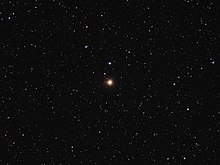| Observation data Epoch J2000 Equinox J2000 | |
|---|---|
| Constellation | Lacerta |
| Right ascension | 22h 29m 31.823s[1] |
| Declination | +47° 42′ 24.79″[1] |
| Apparent magnitude (V) | 4.36[2] |
| Characteristics | |
| Spectral type | K6–M0I + B7/8V[3] |
| U−B color index | +1.11[2] |
| B−V color index | +1.68[2] |
| Variable type | LC[4] |
| Astrometry | |
| Radial velocity (Rv) | −3.4±0.2[5] km/s |
| Proper motion (μ) | RA: −2.554 mas/yr[6] Dec.: −5.372 mas/yr[6] |
| Parallax (π) | 1.4838 ± 0.1383 mas[6] |
| Distance | 2,170+200 −180 ly (665+62 −54 pc)[7] |
| Orbit[5] | |
| Period (P) | 41.95±0.20 yr |
| Eccentricity (e) | 0.49±0.01 |
| Periastron epoch (T) | 2427578.3±260 JD |
| Argument of periastron (ω) (secondary) | 323±5.0° |
| Semi-amplitude (K1) (primary) | 12.2±1.2 km/s |
| Semi-amplitude (K2) (secondary) | 112.0±8.2 km/s |
| Details | |
| 5 Lacertae A | |
| Mass | 5.11±0.18[8] M☉ |
| Radius | 359[9] R☉ |
| Luminosity | 25,100[9][a] L☉ |
| Temperature | 3,790[9][b] K |
| Rotational velocity (v sin i) | 50[10] km/s |
| Age | 110±10[8] Myr |
| 5 Lacertae B | |
| Rotational velocity (v sin i) | 89[2] km/s |
| Other designations | |
| Database references | |
| SIMBAD | data |

5 Lacertae (5 Lac) is a spectroscopic binary in the constellation Lacerta. Its apparent magnitude is 4.36.

5 Lacertae is a slow irregular variable star with a small amplitude. Photometry from the Hipparcos satellite showed brightness changes between Hipparcos magnitudes 4.39 and 4.56 with no clear periodicity.[4] It was given the variable star designation V412 Lacertae in 1999 in a special name-list dedicated to variables detected from Hipparcos.[13]
The spectrum of 5 Lacertae clearly indicates both a hot component and a cooler component, recognised even in early spectra. Published spectral types for the brighter cool component vary from K4 to M0, with a luminosity class of giant or supergiant. The hotter star is generally classed as a relatively unevolved late B or early A star, but an automated classification program gave it a spectral class of B2V.[14]
Radial velocity variations in the absorption lines from the two separate stars have been measured to determine the orbit. This has an unusually long period of almost 42 years. The two stars have an eccentric orbit with a projected axis of about 15 au.[5]
- ^ a b Cite error: The named reference
van Leeuwen2007was invoked but never defined (see the help page). - ^ a b c d Cite error: The named reference
bscwas invoked but never defined (see the help page). - ^ Cite error: The named reference
pantaleoniwas invoked but never defined (see the help page). - ^ a b Cite error: The named reference
gcvswas invoked but never defined (see the help page). - ^ a b c Cite error: The named reference
Hendry1978was invoked but never defined (see the help page). - ^ a b Cite error: The named reference
DR3was invoked but never defined (see the help page). - ^ Cite error: The named reference
b-jwas invoked but never defined (see the help page). - ^ a b Cite error: The named reference
Baines2018was invoked but never defined (see the help page). - ^ a b c Cite error: The named reference
Healy2023was invoked but never defined (see the help page). - ^ Cite error: The named reference
vanbellewas invoked but never defined (see the help page). - ^ Cite error: The named reference
Simbadwas invoked but never defined (see the help page). - ^ Cite error: The named reference
HipDataAccesswas invoked but never defined (see the help page). - ^ Cite error: The named reference
ibvswas invoked but never defined (see the help page). - ^ Cite error: The named reference
skiffwas invoked but never defined (see the help page).
Cite error: There are <ref group=lower-alpha> tags or {{efn}} templates on this page, but the references will not show without a {{reflist|group=lower-alpha}} template or {{notelist}} template (see the help page).
